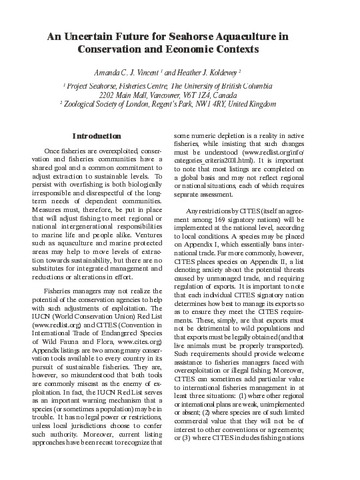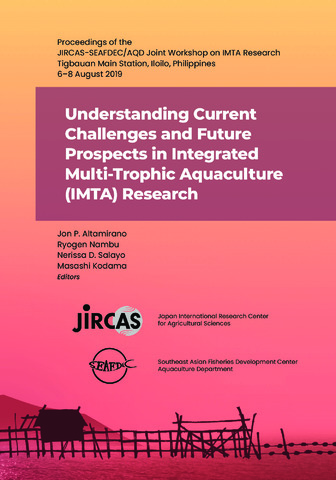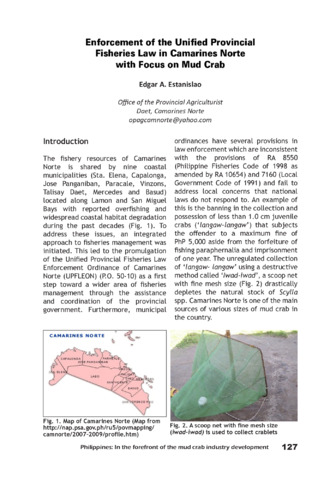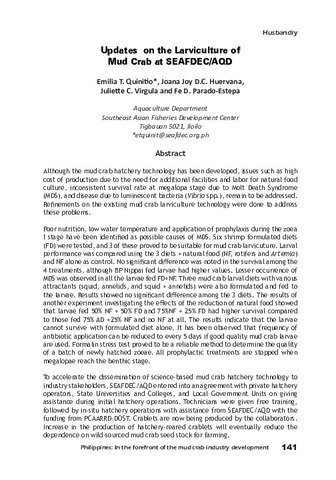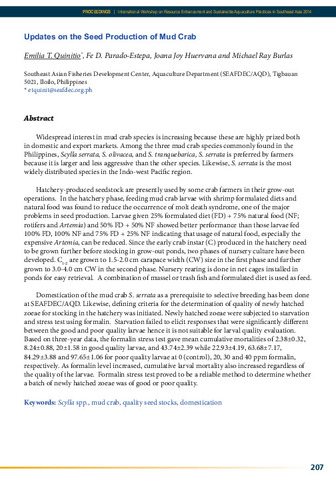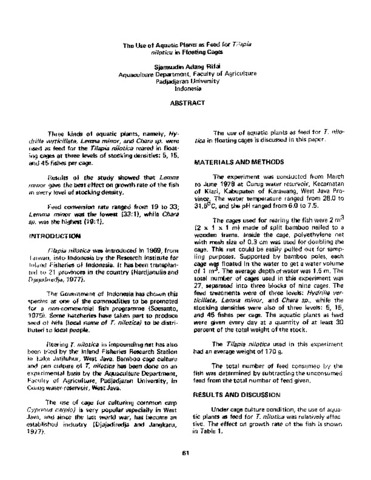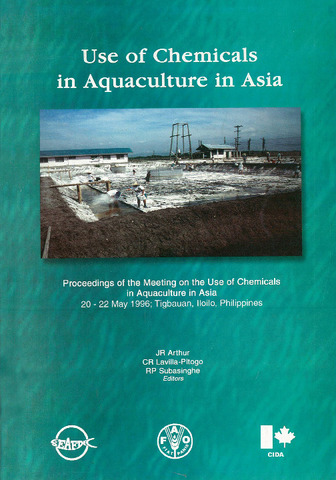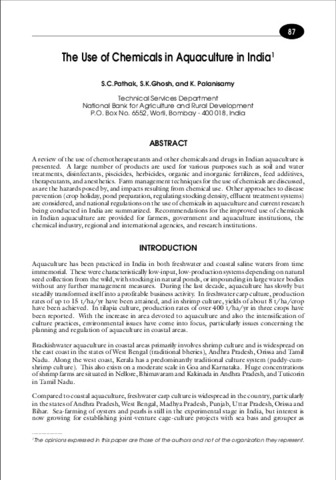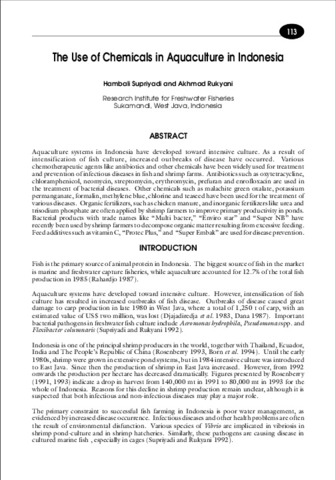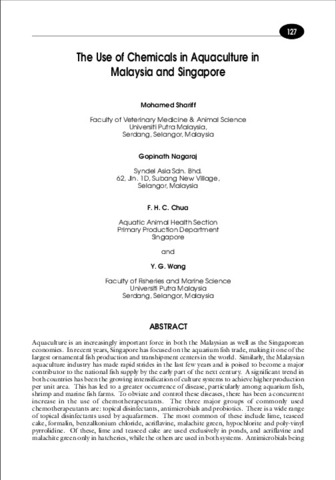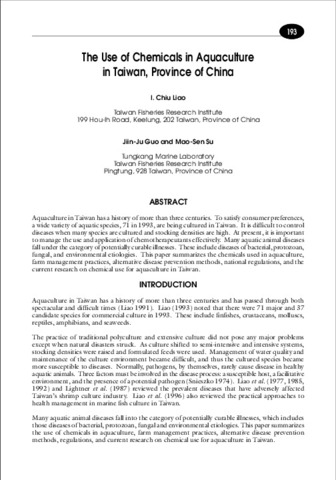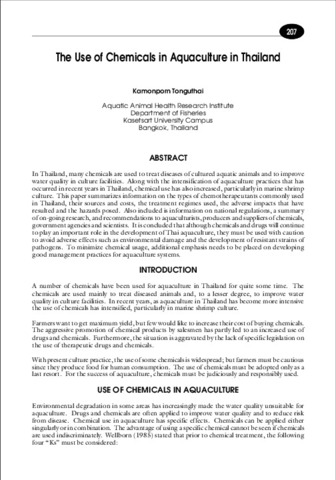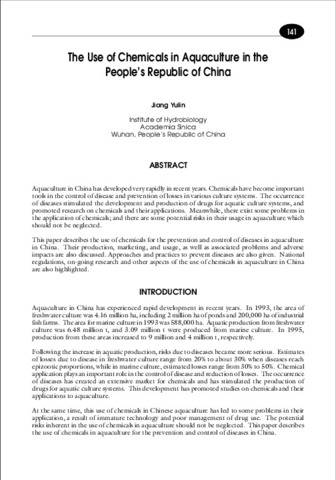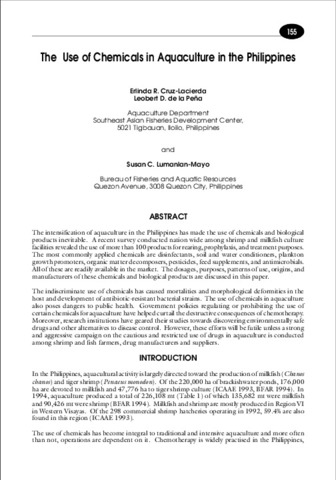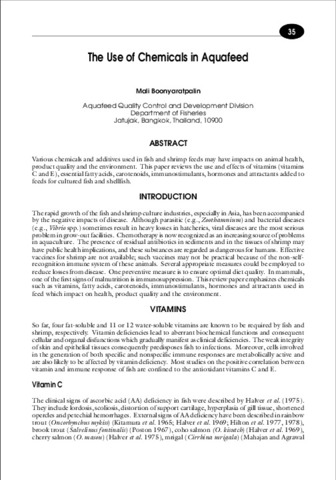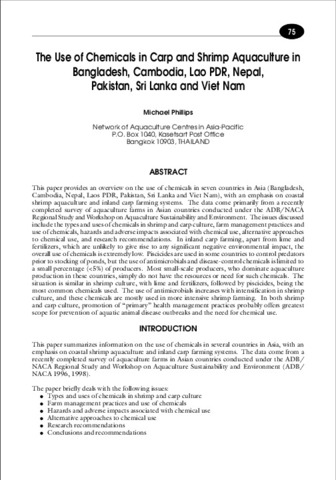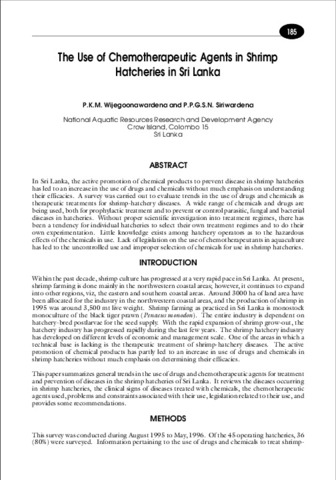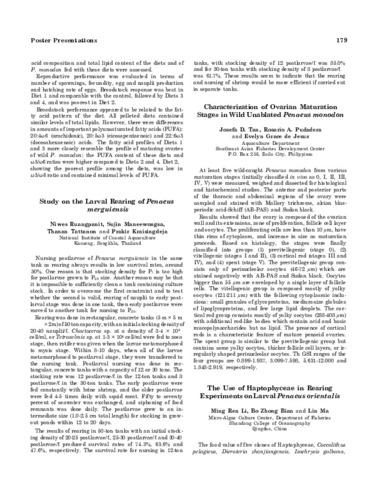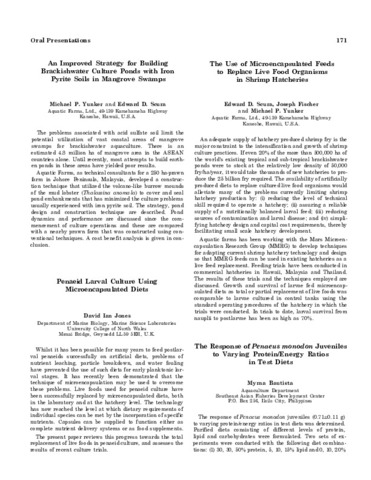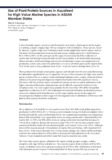Mencari Conference Proceedings berdasarkan Judul
Now showing items 730-749 of 767
-
An uncertain future for seahorse aquaculture in conservation and economic contexts
(Aquaculture Department, Southeast Asian Fisheries Development Center, 2006)Seahorses (family Syngnathidae, genus Hippocampus) have set precedents globally. They were among the first marine fishes of commercial importance to be listed on both the IUCN Red List and CITES Appendix II. Overfishing ... -
Understanding current challenges and future prospects in Integrated Multi-trophic Aquaculture (IMTA) research. Proceedings of the JIRCAS-SEAFDEC/AQD Joint Workshop on IMTA research held at SEAFDEC/AQD, Tigbauan Main Station, Iloilo, Philippines on 6-8 August 2019
(Aquaculture Department, Southeast Asian Fisheries Development Center; Japan International Research Center for Agricultural Sciences, 2022-07)This proceeding is a compilation of the 10-year achievements in IMTA research conducted by JIRCAS and SEAFDEC/AQD researchers and their collaborators, covering topics such as ecological characterization of target species, ... -
Unified provincial fisheries law enforcement of ordinance of Camarines Norte focusing on mud crab
(Aquaculture Department, Southeast Asian Fisheries Development Center, 2017)Due to overfishing and widespread coastal habitat degradation, the Province of Camarines Norte passed a provincial fisheries law enforcement known as the Unified Provincial Fisheries Law Enforcement Ordinance of Camarines ... -
Updates on the larviculture of mud crab at SEAFDEC/AQD
(Aquaculture Department, Southeast Asian Fisheries Development Center, 2017)Although the mud crab (Scylla serrata) hatchery technology has been developed, issues such as high cost of production due to the need for additional facilities and labor for natural food culture, inconsistent survival rate ... -
Updates on the seed production of mud crab
(Aquaculture Department, Southeast Asian Fisheries Development Center, 2015)Widespread interest in mud crab species is increasing because these are highly prized both in domestic and export markets. Among the three mud crab species commonly found in the Philippines, Scylla serrata, S. olivacea, ... -
The use of aquatic plants as feed for Tilapia nilotica in floating cages
(Aquaculture Department, Southeast Asian Fisheries Development Center; International Development Research Centre, 1979)Three kinds of aquatic plants, namely, Hydrilla verticillata, Lemna minor , and Chara sp. were used as feed for the T. nilotica reared in floating cages at three levels of stocking densities: 5, 15, and 45 fishes per cage. ... -
Use of Chemicals in Aquaculture in Asia: Proceedings of the Meeting on the Use of Chemicals in Aquaculture in Asia, 20-22 May 1996, Tigbauan, Iloilo, Philippines
(Aquaculture Department, Southeast Asian Fisheries Development Center, 2000)The use of chemicals is common in various aquaculture systems, as it is in many agricultural practices. However, with growing worldwide awareness of the need for responsible practices in aquaculture, governments and ... -
The use of chemicals in aquaculture in India
(Aquaculture Department, Southeast Asian Fisheries Development Center, 2000)A review of the use of chemotherapeutants and other chemicals and drugs in Indian aquaculture is presented. A large number of products are used for various purposes such as soil and water treatments, disinfectants, piscicides, ... -
The use of chemicals in aquaculture in Indonesia
(Aquaculture Department, Southeast Asian Fisheries Development Center, 2000)Aquaculture systems in Indonesia have developed toward intensive culture. As a result of intensification of fish culture, increased outbreaks of disease have occurred. Various chemotherapeutic agents like antibiotics and ... -
The use of chemicals in aquaculture in Malaysia and Singapore
(Aquaculture Department, Southeast Asian Fisheries Development Center, 2000)Aquaculture is an increasingly important force in both the Malaysian as well as the Singaporean economies. In recent years, Singapore has focused on the aquarium fish trade, making it one of the largest ornamental fish ... -
The use of chemicals in aquaculture in Taiwan, Province of China
(Aquaculture Department, Southeast Asian Fisheries Development Center, 2000)Aquaculture in Taiwan has a history of more than three centuries. To satisfy consumer preferences, a wide variety of aquatic species, 71 in 1993, are being cultured in Taiwan. It is difficult to control diseases when many ... -
The use of chemicals in aquaculture in Thailand
(Aquaculture Department, Southeast Asian Fisheries Development Center, 2000)In Thailand, many chemicals are used to treat diseases of cultured aquatic animals and to improve water quality in culture facilities. Along with the intensification of aquaculture practices that has occurred in recent ... -
The use of chemicals in aquaculture in the People's Republic of China
(Aquaculture Department, Southeast Asian Fisheries Development Center, 2000)Aquaculture in China has developed very rapidly in recent years. Chemicals have become important tools in the control of disease and prevention of losses in various culture systems. The occurrence of diseases stimulated ... -
The use of chemicals in aquaculture in the Philippines
(Aquaculture Department, Southeast Asian Fisheries Development Center, 2000)The intensification of aquaculture in the Philippines has made the use of chemicals and biological products inevitable. A recent survey conducted nation wide among shrimp and milkfish culture facilities revealed the use ... -
The use of chemicals in aquafeed
(Aquaculture Department, Southeast Asian Fisheries Development Center, 2000)Various chemicals and additives used in fish and shrimp feeds may have impacts on animal health, product quality and the environment. This paper reviews the use and effects of vitamins (vitamins C and E), essential fatty ... -
The use of chemicals in carp and shrimp aquaculture in Bangladesh, Cambodia, Lao PDR, Nepal, Pakistan, Sri Lanka and Viet Nam
(Aquaculture Department, Southeast Asian Fisheries Development Center, 2000)This paper provides an overview on the use of chemicals in seven countries in Asia (Bangladesh, Cambodia, Nepal, Laos PDR, Pakistan, Sri Lanka and Viet Nam), with an emphasis on coastal shrimp aquaculture and inland carp ... -
The use of chemotherapeutic agents in shrimp hatcheries in Sri Lanka
(Aquaculture Department, Southeast Asian Fisheries Development Center, 2000)In Sri Lanka, the active promotion of chemical products to prevent disease in shrimp hatcheries has led to an increase in the use of drugs and chemicals without much emphasis on understanding their efficacies. A survey was ... -
The use of haptophyceae in rearing experiments on larval Penaeus orientalis
(Aquaculture Department, Southeast Asian Fisheries Development Center, 1985)The food value of five clones of Haptophyceae, Coccolithus pelagicus, Dicrateria zhanjiangensis, Isochrysis galbana, Tahitian Isochrysis aff. galbana, and Pseudoisochrysis paradoxa were tested for larval Penaeus orientalis. ... -
The use of microencapsulated feeds to replace live food organisms in shrimp hatcheries
(Aquaculture Department, Southeast Asian Fisheries Development Center, 1985)An adequate supply of hatchery produced shrimp fry is the major constraint to the intensification and growth of shrimp culture practices. If even 20% of the more than 500,000 ha of the world's existing tropical and ... -
Use of plant protein sources in aquafeed for high value marine species in ASEAN member states
(Aquaculture Department, Southeast Asian Fisheries Development Center, 2015)Cultured marine aquatic species are predominantly carnivorous. Major species in the region are seabass, grouper, snapper, tiger shrimp, mangrove crab and abalone. These species, except for abalone, require a high level of ...

